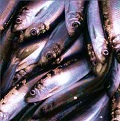 The most populated areas of Puget Sound have experienced striking shifts in marine species, with declines in herring and smelt that have long provided food for other marine life and big increases in the catch of jellyfish, which contribute far less to the food chain, according to new research that tracks species over the last 40 years.
The most populated areas of Puget Sound have experienced striking shifts in marine species, with declines in herring and smelt that have long provided food for other marine life and big increases in the catch of jellyfish, which contribute far less to the food chain, according to new research that tracks species over the last 40 years.
The parallel trends of rising human population and declining forage fish such as herring and smelt indicate that human influences such as pollution and development may be eroding species that long dominated Puget Sound. In particular, the rise of jellyfish blooms may divert energy away from highly-productive forage species that provide food for larger fish and predators such as salmon, seabirds and marine mammals.
The research by scientists from NOAA Fisheries’ Northwest Fisheries Science Center, the University of Washington and the Washington Department of Fish and Wildlife was published April 9 in Marine Ecology Progress Series.
“On land people see the changes that come with human population increases, but underwater the changes are much harder to discern,” said Correigh Greene, a research fisheries biologist at NWFSC and lead author of the new research. “What this tells us is that when you look over time, you can see that the underwater landscape of Puget Sound is changing too.”
The scientists mined data from trawl surveys of fish species in Puget Sound in the 1970s and 80s, in some cases salvaging records destined for the recycling bin and converting handwritten data to electronic format. Then they compared those early results to similar results from their own surveys in 2003 and 2011 to detect changes in the abundance and distribution of forage fish species and jellyfish.
They also looked for connections between the changes in species and outside influences such as human population growth, commercial fishing and shifts in climate.
What they found was declines in some species and increases in others. Pacific herring and surf smelt, historically the two most abundant forage fish, declined by as much as two orders of magnitude in the most heavily populated areas of Puget Sound. Sand lance and three-spine stickleback increased across all four Puget Sound sub-basins examined, but these smaller fish species translate into less prey overall for larger fish, birds and marine mammals.
The Puget Sound Partnership cites Pacific herring as an indicator of ecosystem health in Puget Sound.
Jellyfish blooms also rose alongside human population across Puget Sound, with jellyfish-dominated catches jumping three to nine-fold in the same sub-basins where herring and smelt declined. In some cases more than nine of every 10 tows of trawl survey nets in recent years brought in catches dominated by jellyfish.
The shifts suggest that the same disturbed conditions linked to declines in herring and smelt may benefit more opportunistic jellyfish, which then further pressure forage fish by competing with them for food or even consuming their eggs and larvae. But jellyfish offer far less nutrition than the declining forage fish, reducing the food and energy available to species higher on the food chain.
Harvest of forage fish may open new opportunities for jellyfish by reducing competition from other species and human-driven changes in habitat may reduce the productivity of forage fish, scientists suggest. Polluted runoff may also shift prey towards types that jellyfish favor.
The research may also help resolve the mystery of why juvenile salmon survival has declined sharply in Puget Sound. While forage fish may compete with salmon in some circumstances, they also serve as prey for salmon and can help absorb some pressure from predators such as seals that might otherwise consume young salmon. The parallel declines of forage fish and juvenile salmon survival suggests the loss of forage fish may also affect salmon.
“We still have to pin down mechanisms and causes, but there is clearly a compelling pattern of change in Puget Sound food webs that may be linked to human influence,” said Casey Rice, a research fish biologist at the NWFSC and co-author of the new paper. “These results are a potent reminder of just how important such field studies are in detecting, diagnosing and managing impacts on natural resources.”
Declines in forage fish were most closely related to human population density, while commercial fishing and climate were less important factors, the research found.
The results may help guide habitat protection and restoration by focusing it on less-disturbed parts of Puget Sound that remain important habitat for forage fish, the researchers concluded. The findings also suggest that efforts to rebuild forage fish populations should take into account human pressures that may be driving unrecognized changes in marine ecosystems.
“We were fortunate to find the long-term data that allowed us to detect these changes in Puget Sound,” said Lauren Kuehne, a research scientist at the University of Washington and co-author of the research. “This really demonstrates the value of data that may have been collected many years ago for different reasons but helps us see the changes that are affecting ecosystems today.”
